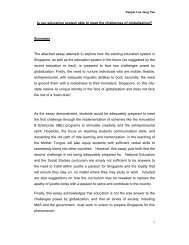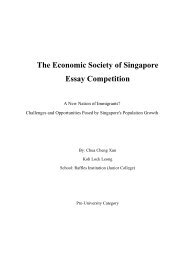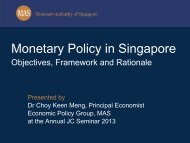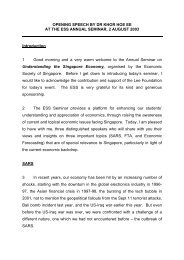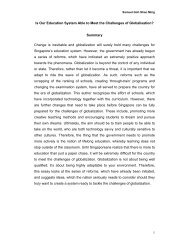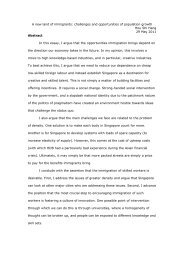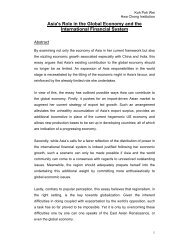the role of the state in an increasingly borderless world - Economic ...
the role of the state in an increasingly borderless world - Economic ...
the role of the state in an increasingly borderless world - Economic ...
- No tags were found...
Create successful ePaper yourself
Turn your PDF publications into a flip-book with our unique Google optimized e-Paper software.
also relatively low because local comp<strong>an</strong>ies, be<strong>in</strong>g normally engaged <strong>in</strong> complementary areas<br />
<strong>of</strong> MNCs as subord<strong>in</strong>ate partners, were less required to raise a large amount <strong>of</strong> <strong>in</strong>vestment<br />
funds. 18 The lower levels <strong>of</strong> foreign debt <strong>an</strong>d corporate debt, comb<strong>in</strong>ed with its strong position<br />
<strong>in</strong> foreign reserve, were factors that helped S<strong>in</strong>gapore to be less vulnerable to external f<strong>in</strong><strong>an</strong>cial<br />
shocks, although its f<strong>in</strong><strong>an</strong>cial market was wide open to <strong>in</strong>ternational f<strong>in</strong><strong>an</strong>cial flows.<br />
However, this does not imply that what lies ahead <strong>of</strong> <strong>the</strong> S<strong>in</strong>gapore<strong>an</strong> <strong>state</strong> is <strong>an</strong> easy<br />
task, or it will be all right if it simply sticks to <strong>the</strong> previous way <strong>of</strong> m<strong>an</strong>ag<strong>in</strong>g <strong>the</strong> economy. It is<br />
still a formidable task to <strong>an</strong>ticipate <strong>the</strong> next growth area <strong>an</strong>d attract <strong>in</strong>vestments <strong>the</strong>re while<br />
provid<strong>in</strong>g <strong>an</strong>d upgrad<strong>in</strong>g necessary complementary assets. As <strong>the</strong> pace <strong>of</strong> globalisation<br />
accelerates, <strong>the</strong> <strong>state</strong> needs to accelerate its efforts at upgrad<strong>in</strong>g complementary assets <strong>in</strong> <strong>the</strong><br />
economy.<br />
In particular, as <strong>the</strong> <strong>in</strong>come level <strong>of</strong> <strong>the</strong> country reaches that <strong>of</strong> <strong>an</strong> adv<strong>an</strong>ced country, <strong>the</strong><br />
<strong>state</strong> seems to face a challenge that is qualitatively different from previous ones. One<br />
weakness <strong>of</strong> <strong>the</strong> complement<strong>in</strong>g strategy lies <strong>in</strong> <strong>the</strong> relative underdevelopment <strong>of</strong> domestic<br />
technological capability. This is because countries adopt<strong>in</strong>g complement<strong>in</strong>g strategies do not<br />
have strong <strong>in</strong>centives to <strong>in</strong>vest <strong>in</strong> R&D as MNCs are sources <strong>of</strong> major technologies. Reflect<strong>in</strong>g<br />
this, S<strong>in</strong>gapore’s expenditure on R&D <strong>in</strong>vestment had been very low even until <strong>the</strong> early 1990s<br />
when it reached <strong>the</strong> adv<strong>an</strong>ced country status. 19 And <strong>the</strong> weakness <strong>in</strong> <strong>the</strong> private sector R&D<br />
capability is more pronounced <strong>in</strong> comparison with o<strong>the</strong>r East Asi<strong>an</strong> countries, as figure 1 shows.<br />
While S<strong>in</strong>gapore rema<strong>in</strong>s a catch<strong>in</strong>g-up country, it might have been sufficient to try to<br />
f<strong>in</strong>d bus<strong>in</strong>ess areas that MNCs were will<strong>in</strong>g to part with <strong>an</strong>d attract <strong>the</strong>m by provid<strong>in</strong>g<br />
complementary assets. Fortunately for S<strong>in</strong>gapore, <strong>the</strong> acceleration <strong>of</strong> globalisation has<br />
cont<strong>in</strong>uously exp<strong>an</strong>ded <strong>the</strong> complementary bus<strong>in</strong>ess areas even to higher-end m<strong>an</strong>ufactur<strong>in</strong>g<br />
<strong>an</strong>d service sectors, <strong>an</strong>d leng<strong>the</strong>ned <strong>the</strong> life sp<strong>an</strong> <strong>of</strong> <strong>the</strong> complement<strong>in</strong>g strategy. However, it<br />
seems to me that <strong>the</strong>re is a certa<strong>in</strong> limit to <strong>the</strong> atta<strong>in</strong>able growth through <strong>the</strong> complement<strong>in</strong>g<br />
strategy because <strong>of</strong> <strong>the</strong> difficulty <strong>in</strong> acquir<strong>in</strong>g core technologies.<br />
From <strong>the</strong> viewpo<strong>in</strong>t <strong>of</strong> MNCs, <strong>the</strong> core R&D capability, which is related with <strong>the</strong><br />
development <strong>of</strong> new products <strong>an</strong>d processes, is <strong>the</strong> last th<strong>in</strong>g that <strong>the</strong>y will tr<strong>an</strong>sfer to local<br />
subsidiaries. In fact, one pr<strong>in</strong>cipal reason why MNCs globalise <strong>the</strong>ir operations is that<br />
economies <strong>of</strong> scale <strong>an</strong>d scope <strong>in</strong>volved <strong>in</strong> <strong>the</strong>ir core R&D activities are ever-<strong>in</strong>creas<strong>in</strong>g <strong>an</strong>d <strong>the</strong>y<br />
have to recoup <strong>the</strong> costs <strong>in</strong> new technology development. 20 It does not make economic sense<br />
for MNCs to separate <strong>the</strong>ir core R&D activities geographically. It is still <strong>an</strong> overall trend that<br />
MNCs concentrate <strong>the</strong>ir higher value-added production processes, <strong>in</strong>clud<strong>in</strong>g R&D, <strong>in</strong> <strong>the</strong>ir home<br />
countries. Although MNCs set up regional R&D centres, technologies tr<strong>an</strong>sferred or developed<br />
<strong>the</strong>re are mostly limited to those related with adapt<strong>in</strong>g <strong>the</strong>ir products to rapidly-ch<strong>an</strong>g<strong>in</strong>g local<br />
market conditions. 21 No matter how far globalisation progresses <strong>an</strong>d no matter how hard<br />
18 The corporate debt-equity ratio <strong>of</strong> S<strong>in</strong>gapore<strong>an</strong> firms, <strong>in</strong>clud<strong>in</strong>g that <strong>of</strong> MNCs, was <strong>the</strong>refore around 123% dur<strong>in</strong>g<br />
<strong>the</strong> 1980-91, much lower th<strong>an</strong> that <strong>of</strong> Korea (383%) dur<strong>in</strong>g <strong>the</strong> same period (Sh<strong>in</strong> 2002).<br />
19 The gross expenditure on R&D (GERD) <strong>of</strong> S<strong>in</strong>gapore was 0.21% <strong>in</strong> 1981 <strong>an</strong>d <strong>in</strong>creased only to 0.84% <strong>in</strong> 1990.<br />
Dur<strong>in</strong>g <strong>the</strong> same period, Korea’s figure jumped from 0.65% to 1.95% whilst Taiw<strong>an</strong>’s rose from 0.84% to 1.66%.<br />
S<strong>in</strong>gapore’s GERD beg<strong>an</strong> <strong>in</strong>creas<strong>in</strong>g sharply only after it reached <strong>the</strong> adv<strong>an</strong>ced country status <strong>an</strong>d its <strong>state</strong> <strong>in</strong>vested<br />
heavily <strong>in</strong> R&D <strong>in</strong> <strong>the</strong> 1990s. In 1999, S<strong>in</strong>gapore’s GERD nearly levelled that <strong>of</strong> Taiw<strong>an</strong> (1.84%), though still lower<br />
th<strong>an</strong> that <strong>of</strong> Korea (2.46%) (Wong 2001; Hou & Gee 1993; Sh<strong>in</strong> & Ch<strong>an</strong>g 2003, figure 2.7).<br />
20 Refer to Freem<strong>an</strong> & Hagedoorn (1995); Pavitt & Patel (1999).<br />
21 Amsden et al. (2001: 3) po<strong>in</strong>t out this aspect with <strong>the</strong>ir case study <strong>of</strong> <strong>the</strong> hard disk drive <strong>in</strong>dustry as follows. “In<br />
1995, Sou<strong>the</strong>ast Asia (mostly S<strong>in</strong>gapore) had virtually no nationally controlled HDD comp<strong>an</strong>ies, but it accounted for<br />
as much as 64% <strong>of</strong> f<strong>in</strong>al global assembly <strong>an</strong>d 44% <strong>of</strong> total global employment ... Sou<strong>the</strong>ast Asia’s wage bill, however,<br />
was only 13% <strong>of</strong> <strong>in</strong>dustry wages <strong>world</strong>wide. Developed economies (Europe, Jap<strong>an</strong> <strong>an</strong>d <strong>the</strong> US), by contrast,<br />
controlled <strong>the</strong> ownership <strong>of</strong> <strong>the</strong> HDD <strong>in</strong>dustry’s lead<strong>in</strong>g enterprises <strong>an</strong>d were responsible for virtually all <strong>of</strong> its R&D.<br />
These economies accounted for less th<strong>an</strong> one-third <strong>of</strong> both f<strong>in</strong>al assembly <strong>an</strong>d total employment but captured more<br />
th<strong>an</strong> three-fourths <strong>of</strong> <strong>the</strong> HDD <strong>in</strong>dustry’s wage bill”.<br />
19



